Table of Contents
Introduction
In this detailed article by Noni, we aim to present a complete guide on the types of optical filters, organized according to various classification criteria. By exploring these different classifications, we provide a comprehensive overview that will enhance your understanding of optical filters and their diverse applications. Whether you are interested in function-based categorizations, spectral band differentiations, film material distinctions, or application-specific characteristics, this guide will offer valuable insights and knowledge. Join us as we delve into the world of optical filters and unravel their complexities.
What is optical filter?

Optical filters, as passive optical devices, play a vital role in selecting the desired wavelength band of radiation. They are created by introducing special dyes or evaporating optical films onto plastic or glass substrates. This alters the refractive index, enabling the transmission of specific wavelengths while reflecting, transmitting, or absorbing other incident light.
By manipulating the filter’s structure and optical parameters, a wide range of spectral characteristics can be achieved. This empowers the filter to control, adjust, and transform the transmission, reflection, polarization, or phase state of light waves. Such versatility makes optical filters indispensable in various optical tools and systems, including chemical analysis devices and microscopes.
Two Typical Optical Filters Types
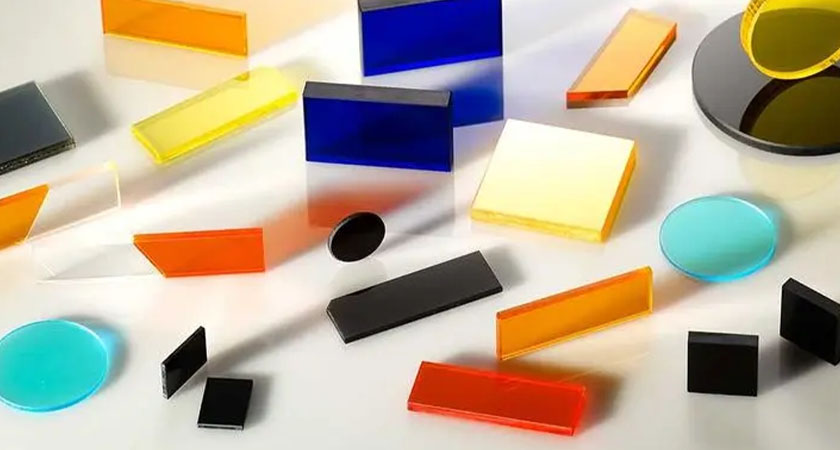
Though there is a diverse range of optical filter types, filters can be broadly classified based on their filtering mechanisms into absorptive filters and dichroic (or interference) filters. While both types filter light, their differentiation lies in the methods employed to block unwanted wavelengths.
Absorptive Filters
These filters, typically constructed with glass substrates, operate based on the inherent absorption properties of the glass. These filters incorporate coatings of organic and inorganic materials that selectively absorb specific wavelengths of light while transmitting desired wavelengths. Unlike reflective filters, absorbed light is not reflected, but contained within the filter itself, resulting in increased temperature during operation.
One key advantage of absorptive filters is their angle insensitivity. They maintain their transmissive and absorptive properties regardless of the incident angle. Absorptive filters are particularly effective in scenarios where unwanted light within the system can introduce optical signal noise.
Color glass filters are the most prevalent type, offering stability, uniformity, good optical quality, and relatively affordable pricing. However, their passband tends to be relatively broad, usually exceeding 30nm.
Dichroic Filters
Comprised of precisely layered optical coatings, dichroic filters function in a manner opposite to absorptive filters, they reflect rather than absorb unwanted wavelengths while transmitting the desired wavelength range. By incorporating coatings with different refractive indices, it becomes possible to selectively reflect or transmit specific wavelength ranges with great precision. This characteristic enables users to precisely target narrow ranges of wavelengths, making dichroic filters highly effective in scientific applications.
Dichroic filters find practical application in cameras, where they are utilized to separate light wavelengths based on film specifications. Their ability to provide accurate and precise control over light properties proves beneficial in various fields, including scientific research, where meticulous control is required.
Optical filters exhibit diverse characteristics that render them suitable for specific applications. Besides the functional classification mentioned earlier, filters can also be categorized based on the spectral band, spectral characteristics, film material, and application-specific attributes. This classification provides convenience in selecting the appropriate filter for various fields and applications.
Optical Filters Types by Spectral Band
Filters can be differentiated based on the spectral band they operate in. This classification includes ultraviolet (UV) band filters, visible light filters, and infrared (IR) band filters.
UV filters typically work within the wavelength range of 180-400nm, visible light filters operate within 400-700nm, near-infrared filters cover 700-3000nm, and infrared filters extend beyond 3000nm up to 10um or more.
Wavelength of UV filter: 180~400nm
Wavelength of Visible light filter: 400~700nm
Wavelength of Near-infrared filter: 700~3000nm
Wavelength of Infrared filter: 3000nm~10um or more
This categorization enables a precise selection of filters based on specific wavelength requirements.
Optical Filters Types by Spectral Properties
Filters can be classified into band-pass filters, cut-off filters, neutral density filters, reflective filters, etc. according to their spectral characteristics.
Types of Bandpass Filters
A bandpass filter selectively permits light of a specific wavelength to pass through while blocking light outside the desired range. It functions by combining a short pass filter and a long pass filter to eliminate wavelengths that are either too short or too long. The width of the passband can be adjusted by modifying the number of layers within the filter.
Optical parameters used to characterize bandpass filters include the central wavelength (CWL), half bandwidth (FWHM), central wavelength transmittance (Tp), cutoff degree, and cutoff range. Depending on requirements, the passband of a bandpass filter can span from infrared to ultraviolet wavelengths. These filters are classified as narrowband or broadband based on the bandwidth-to-center-wavelength ratio, with narrowband filters having a bandwidth of less than 30nm and broadband filters having a bandwidth greater than 60nm.
Narrowband filters offer a narrower passband for highly specific applications, while broadband filters provide a wider range of wavelengths. This classification facilitates precise filtering and ensures optimal performance for diverse optical applications.
Shortpass Filters

Shortpass filters, also known as lowpass filters, allow the transmission of light shorter than a designated wavelength defined by the optical coating and substrate while blocking light with longer wavelengths.
These filters are commonly employed to isolate specific higher regions within a broad spectrum and are often combined with long-pass filters to achieve bandpass filtering for various applications.
Typical uses of short pass filters include chemical analysis systems, where they contribute to precise wavelength selection and light manipulation.
Longpass Filters
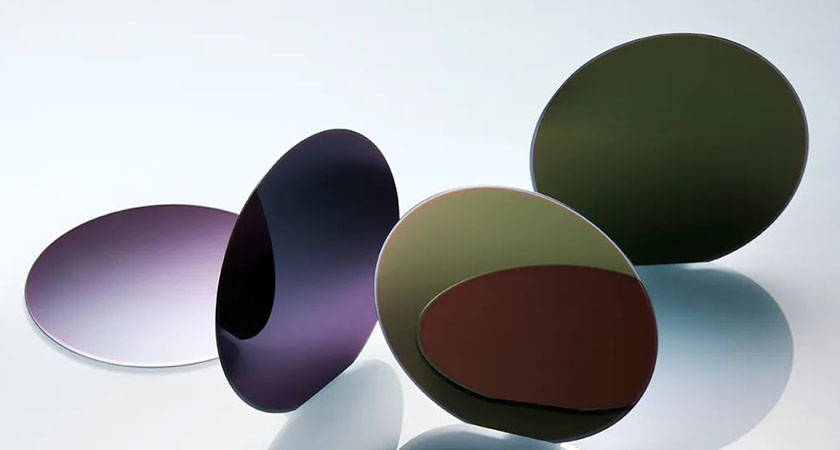
Longpass filters, commonly composed of colored glass, possess transparency to longer wavelength spectra, including infrared, ultraviolet, and visible light. They enable the transmission of wavelengths beyond a specific cutoff determined by the substrate and optical coating while blocking shorter wavelengths.
These filters find widespread use in various applications. In fluorescence spectroscopy systems, they serve as emission filters within fluorescence microscopes. Additionally, they play a crucial role as dichroic (one-way) mirrors. Longpass filters are often employed alongside short-pass filters to achieve band-pass filtering in diverse optical applications.
Neutral Density Filter
Neutral density filters, also called attenuators, can be either absorptive or reflective. The part of the light that is not transmitted is absorbed or reflected to uniformly reduce the transmission in a certain part of the spectrum. This type of filter is useful in photography to prevent strong light from damaging the camera sensor or other optics, allowing users to accurately capture images even in bright light.
Notch Filter
Known as Band Stop Filters or Band Stop Filters, these types of optical filters are ideal for applications involving the combination of two or more signals because they can help isolate interference.
Optical Filters Types by Film
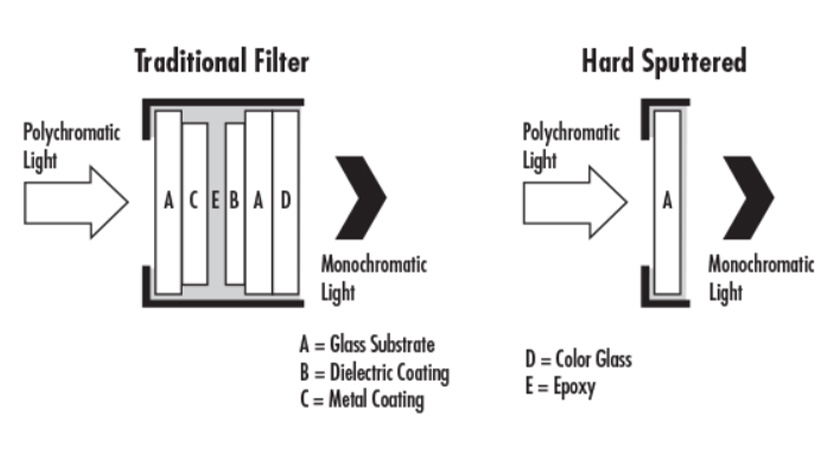
Filters can be categorized into two types based on the applied film materials: soft film filters and hard film filters.
Soft film filters include thin-film absorption filters and thin-film interference filters. Thin-film absorption filters are created by chemically etching specific material substrates to achieve absorption at the desired wavelength. These filters are commonly used for transmitting longer wavelengths, especially in applications requiring infrared filtering. On the other hand, thin-film interference filters are formed by depositing alternating layers of high and low refractive index materials, such as metal-dielectric-metal films or all-dielectric films, onto a substrate through vacuum coating.
Hard film filters, apart from denoting the film’s hardness, are primarily characterized by their laser damage threshold. These filters are extensively employed in laser systems due to their capability to withstand high laser intensities without sustaining damage. In contrast, soft film filters find significant usage in biochemical analyzers and related applications.
By employing these distinct types of filters, various industries and applications can effectively manipulate and control the transmission, absorption, and interference of light to meet their specific requirements.
Optical Filters Types by Application

According to the classification of application characteristics, filters can be categorized into various types, including filters for medical biochemical instruments, filters for fluorescence microscopes, and multi-band dura mater filters for police, among others.
In laser experimental applications, optical filters play a crucial role. Laser safety glasses serve as optical filters worn to protect the eyes from laser radiation. These glasses are designed to filter out specific wavelengths, allowing users to observe their surroundings while conducting optical experiments with the laser active. It is of utmost importance to wear safety glasses that are appropriate for the specific wavelength of the laser being used.
Filters also serve as vital optical components in laser experiments. For instance, when measuring the photoluminescence (PL) of a material, all light emitted from a spot excited by a laser is collected into an optical fiber and analyzed in a spectrometer. The laser light is often intense, and depending on the photoluminescence wavelength, it can overshadow the desired signal. By incorporating a laser wavelength filter between the sample and the lens that collects the emitted light, the laser peak can be reduced or eliminated, allowing for a clear observation of the photoluminescence peak.
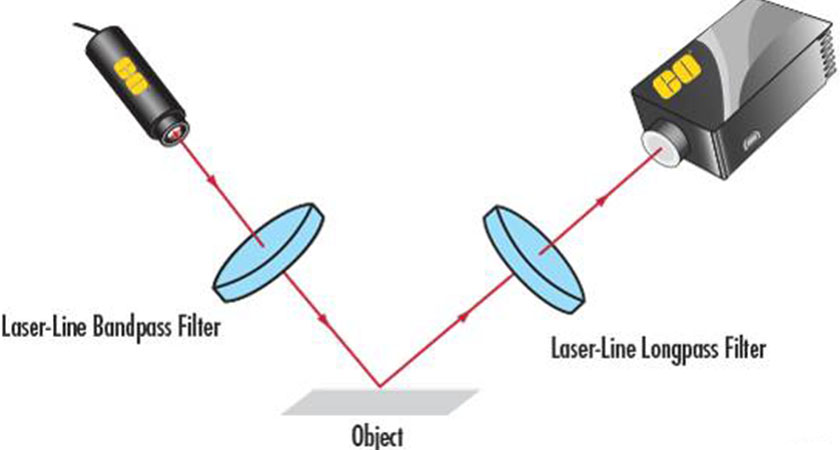
The strategic implementation of optical filters in laser experiments ensures accurate measurements and enhances the visibility of desired signals while mitigating the interference caused by intense laser light.
Other Types of Optical Filters
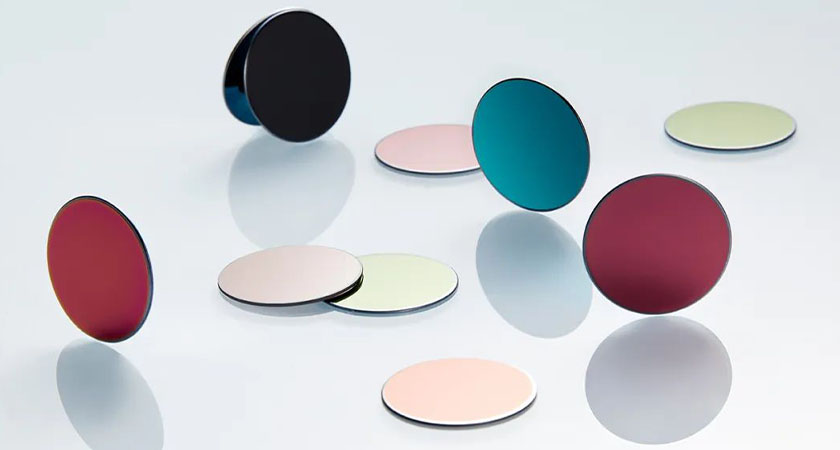
In addition to the optical filters types mentioned above, several other types of filters serve specific purposes:
Monochrome filter:
A monochromatic filter is an extreme case of a bandpass filter that transmits only a single color. It allows a very narrow range of wavelengths to pass through while blocking all others.
Infrared filter:
An infrared filter is designed to transmit visible light while blocking the mid-infrared spectrum. It is commonly used in applications where heat absorption is desired, such as in incandescent bulbs.
UV filter:
UV filters effectively block the ultraviolet range of the spectrum while transmitting visible light. They are commonly used in cameras to protect the film from UV light, which can cause unwanted effects. By filtering out UV wavelengths, they help capture images that closely match what the human eye perceives.
Polarizing filter:
Polarizing filters selectively block or transmit light based on its polarization. They are particularly effective in reducing reflections from surfaces such as water or shiny objects. Polarizing filters are commonly used in sunglasses and camera lenses to improve visibility and manage reflections. In color photography, they can darken bright areas, such as the sky, that have high levels of ultraviolet light.
How to Choose Optical Filters
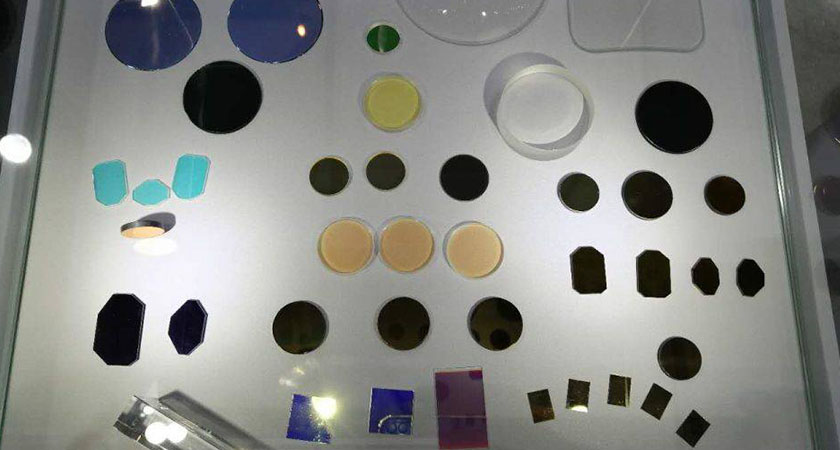
Although there are many types of filters, they all serve the same basic function—transmitting a specific wavelength or color range of light while blocking the rest of the color spectrum. When choosing the right filter, the following aspects should be considered:
Determine the desired function of the optical filter in the optical path, such as cut-off, bandpass, spectroscopic, or attenuation. This will help identify the specific type of optical filter required.
Consider the spectral range of transmission, reflection, or attenuation needed for the optical path, as well as factors like transmittance and size. These parameters will guide the selection process to ensure the filter meets the specific requirements of the application.
By carefully considering these aspects, one can make an informed decision and choose the most suitable filter for their intended purpose in the optical system.
Conclusion
In this comprehensive article, we have explored the diverse world of optical filters. By considering various factors, we have classified them into different types, providing a clear and informative guide. We have delved into their classifications based on function, spectral band, film material, application characteristics, and more. By covering these classification criteria, we aim to provide you with a well-rounded understanding of optical filters and their applications.

Noni is a leading custom optics production and development company with extensive experience in the industry of optical components and systems. Since our establishment in 2014, we have been committed to providing exceptional services to our clients worldwide. Our team comprises experts who have been in the optics field since 2008, ensuring that we deliver top-quality products and reliable services to meet our client’s diverse needs.
If have particular specifications for aspheric lens or other optics in customization, or you need support in the R&D and manufacturing of tailored optics of higher accuracy and special sizes for your projects or applications, Noni is ready to be a reliable helper with our custom abilities to exceed your expectations via the one-package solution.































